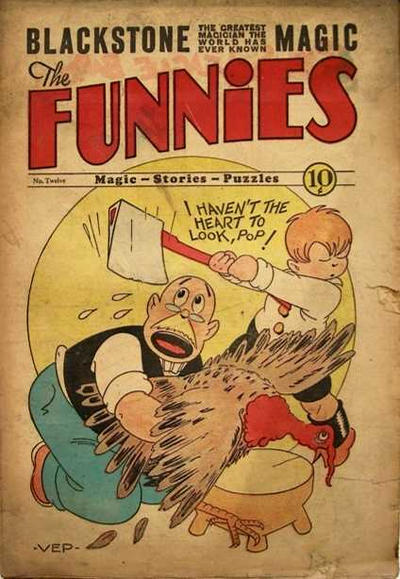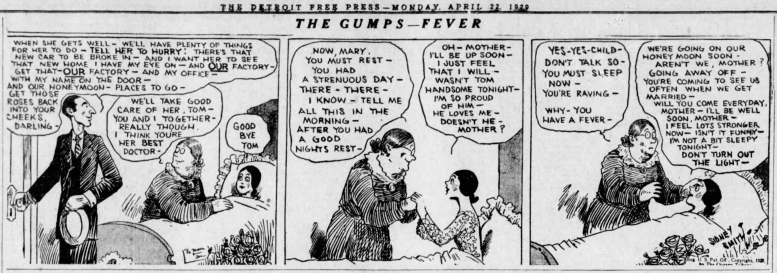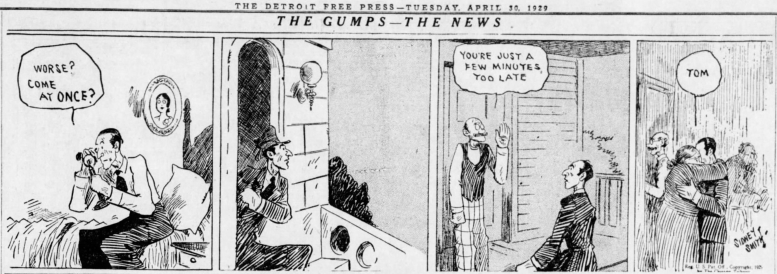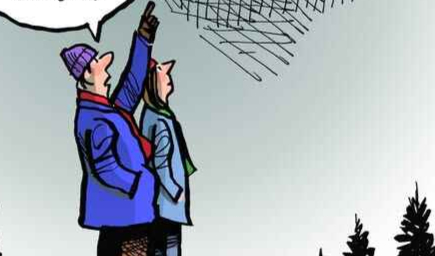Popeye the Public Domain Man
Skip to comments2025 brings with it a new batch of public domain creations, most famous among those from the comics are Popeye by E. C. Segar and Tintin by Hergé. I know little about Tintin so we’ll go with The Sailor Man.
But first, as is our custom with public domain stories, we turn to the Duke Law School:

On January 1, 2025, thousands of copyrighted works from 1929 will enter the US public domain, along with sound recordings from 1924. They will be free for all to copy, share, and build upon. 2025 marks a milestone: all of the books, films, songs, and art published in the 1920s will now be public domain. The literary highlights from 1929 include The Sound and the Fury by William Faulkner, A Farewell to Arms by Ernest Hemingway, and A Room of One’s Own by Virginia Woolf. In film, Mickey Mouse speaks his first words, the Marx Brothers star in their first feature film, and legendary directors from Alfred Hitchcock to John Ford made their first sound films. From comic strips, the original Popeye and Tintin characters will enter the public domain [emphasis added]. Among the newly public domain compositions are Gershwin’s An American in Paris, Ravel’s Bolero, Fats Waller’s Ain’t Misbehavin’, and the musical number Singin’ in the Rain. Below is just a handful of the works that will be in the US public domain in 2025. To find more material from 1929, you can visit the Catalogue of Copyright Entries…

Popeye appeared in the middle of an ongoing Thimble Theater story as a bit player on January 17, 1929. During the course of the story Popeye’s role became the highlight and by the end he was the heroic focus who would return to the strip later that 1929 year as the star. The rest is well-known history. But…
It is only the 1929 Popeye that is entering public domain. Other characters and characteristics will have to wait. Wimpy wouldn’t come along until 1931, the spinach enhancement was also introduced in 1931, Bluto in 1932 and Swee’Pea in 1933.
Olive Oyl, Ham Gravy, and Castor Oyl had been around for a decade; and the all-important Bernice, the Whiffle Hen had come into the story in 1928. The Sea Hag was mentioned in December 1929 but only barely shown in a shadowy profile. Hardly anything to work with. Yet she did appear in 1929 though any personality traits would have to wait until 1930.
January 1929 would see another comic strip that would become famous, so famous the name would give its name to describe the genre it popularized on the funny pages. That Buck Rogers stuff.

Anthony Rogers had appeared in a pulp story by Philip Nowlan in 1928. In 1929, with Richard Calkins as artist, and a name change to “Buck” Rogers he and Wilma Deering began their famous futuristic adventures.
But as the above Duke essay notes Buck Rogers has been public domain for years:
The character Buck Rogers first appeared in 1929 and is public domain in 2025, but technically the futuristic space hero has already been copyright-free for decades, despite claims that he was still copyrighted. This is because the copyright registration for the Buck Rogers comic strip was not renewed, so that its copyright expired after 28 years. Also, the original version of the character was actually introduced in a novella as “Anthony Rogers” in 1928; that character has long been public domain as well.
Another character that first appeared in the pulps and who has been public domain is Tarzan of the Apes. But E. R. Burroughs, Inc. has jealously guarded their copyright so it is only now that the comic strip adaptation of that story by R. W. Palmer and Hal Foster is entering public domain.


R. W. Palmer would return in 1929 to adapt The Return of Tarzan into comic strip format, this time with artists Hugh Hutton and Rex Maxon illustrating the adventure.
Okay. One more character that had previously appeared that began a comic strip life in 1929.

The “slightly risqué” character of Dixie Dugan was created by J. P. McEvoy in 1928. LIke Buck Rogers the creator also scripted the resulting comic strip that was drawn by J. H. Striebel, who had illustrated the Show Girl serials that had run in Liberty magazine.



Before we move on to a few more comic strips let’s detour to the comic book market with “the first.”
As the Grand Comic Book Database tells it:
This can be considered the very first newsstand comic book, put out by Dell Publishing nearly a decade before it hooked up with Western Publishing. It consisted of all-new, all original [emphasis added] material in tabloid form, and it resembled a 16-page, 10.5″ x 15.5″ color Sunday newspaper comics section more than a modern comic book, though it was sold on newsstands…
The first baker’s dozen of issues came out in 1929. I get the feeling that when Dell put out the call to cartoonists they responded with comics that had been rejected by the syndicates. That said the comic book featured many well-known cartoonists such as Joe Archibald, Boody Rogers, Tack Knight, Stookie Allen, Buford Tune, Victor Pazmino, Mo Leff, Courtney Dunkel, Ted O’Loughlin, Art Helfant, and others.
It is probable that The Funnies contents entered public domain long ago, its copyrights not being renewed.
Allan Holtz reviews some of the comic strips in the comic book and profiles some of the cartoonists.

The poor quality of this Connie debut image from 1929 does not do artist Frank Godwin‘s talents justice. Godwin is considered one of the top tier comic artists and magazine illustrators.


Jimmy Hatlo took the phrase They’ll Do It Every Time in 1929 and made a fine living with it.

Terry Gilkison‘s Pinky Dinky didn’t make it through 1930 though the cartoonist did newspaper comics from the 1920s through the 1930s while supplementing his income with pulp illustrations and then comic books.
While Wally Bishop‘s Muggs McGinnnis ran for 45 years getting Wally some mentions in comic history books. (Note: some say Muggs began in 1928, some even say 1927, but I can find no evidence of anything earlier than 1929).

Among the forgotten 1929 debuts like Annibelle by Dorothy Urfer, Teddy, Jack and Mary by Tom McNamara, or Bonzo by George E. Studdy there was one that did stand out.

Count Screwloose of Tooloose by the famed Milt Gross tops the group that Paul Tumey calls Screwball Comics. It began as a Sunday page on February 17, 1929.

But all the debuts and characters above pale next to the biggest comic strip story of 1929.








The year long Saga of Mary Gold (and Tom Carr) began in 1928 and came to a sad end in 1929.
The tragic ending was news around the nation – for some it was front page news above the fold!





The Saga of Mary Gold is available as part of The Library of American Comics Essentials collection.

Anyway…

More about the January 1, 2025 public domain at Copyright Lately.
On January 1, 2025, the U.S. public domain officially welcomes the comic debuts of Popeye and Buck Rogers, alongside classic works by Faulkner, Hemingway, and landmark sound films from the year talkies took over. Here’s what it all means...
… This year’s public domain class also welcomes several iconic comic characters who made their debuts in 1929, starting with Popeye. The gruff sailor first appeared on January 17, 1929, as a minor character in E.C. Segar’s Thimble Theatre comic strip. The strip initially focused on Olive Oyl and her boyfriend, Ham Gravy, but Popeye’s scrappy, no-nonsense attitude quickly made him a fan favorite. He eventually replaced Ham as Olive’s love interest and became the centerpiece of the strip.
Joining Popeye in the 2025 public domain are the earliest comic strips featuring sci-fi hero Buck Rogers. First introduced as “Anthony Rogers” in Philip Francis Nowlan’s 1928 novella Armageddon 2419 A.D. (already in the public domain), the character was renamed Buck and reimagined as a more action-driven hero for his January 1929 comic strip debut, Buck Rogers in the 25th Century A.D.
Buck Rogers’ path to the public domain has been anything but smooth…
Buck and Popeye will also be joined by the first daily comic strip featuring Edgar Rice Burroughs’ Tarzan of the Apes, part of a series that lasted for over forty years.
A warning not to use any of the above as a legal basis to use the characters here to make a buck or two.
We are not lawyers and there are other considerations. We didn’t even mention trademarks.


Comments 1
Comments are closed.